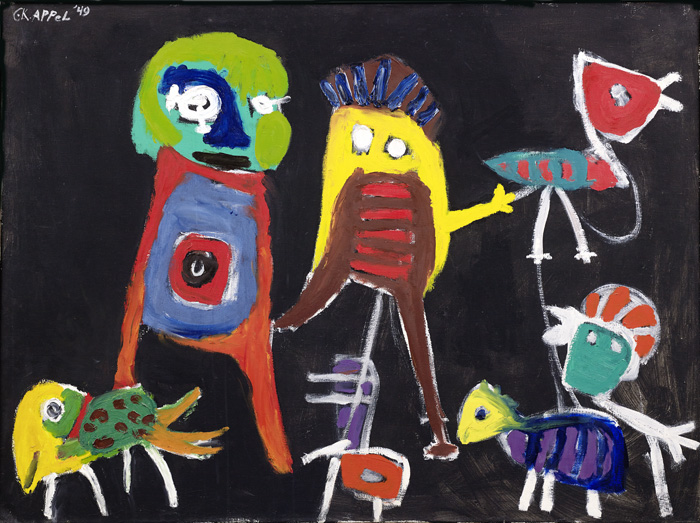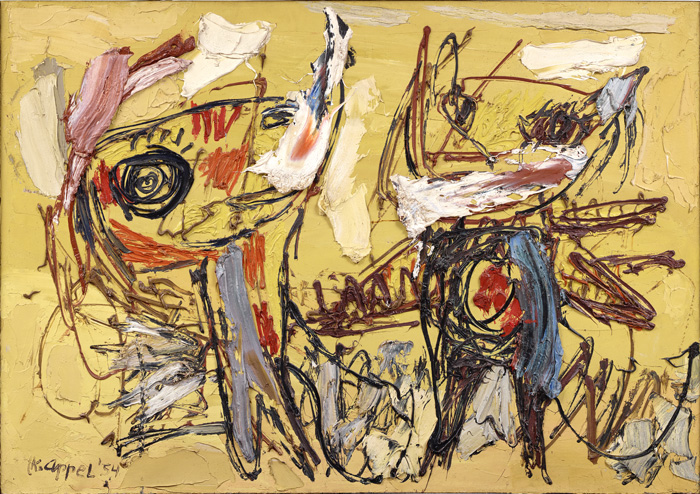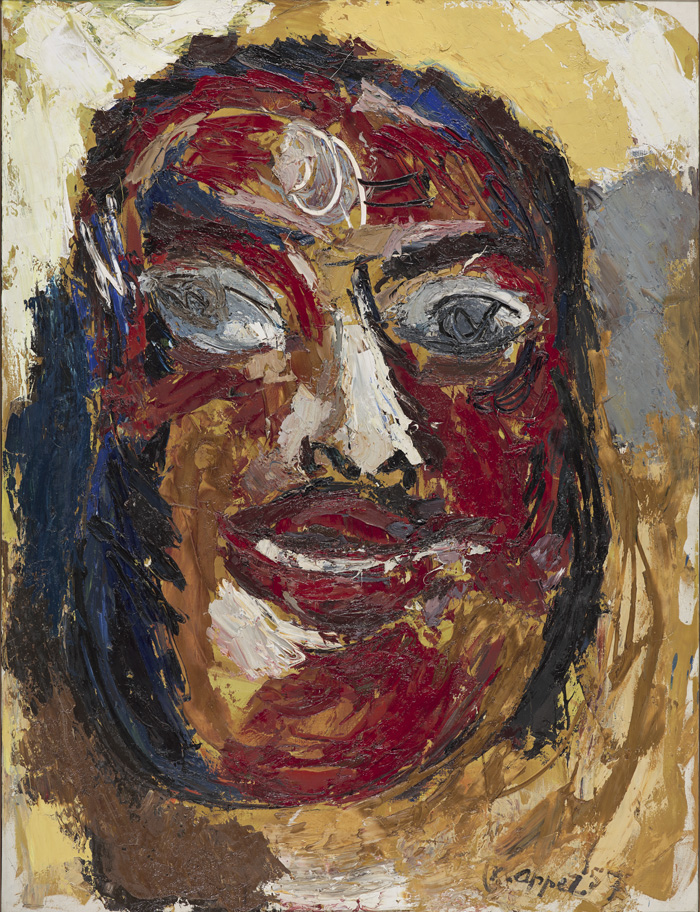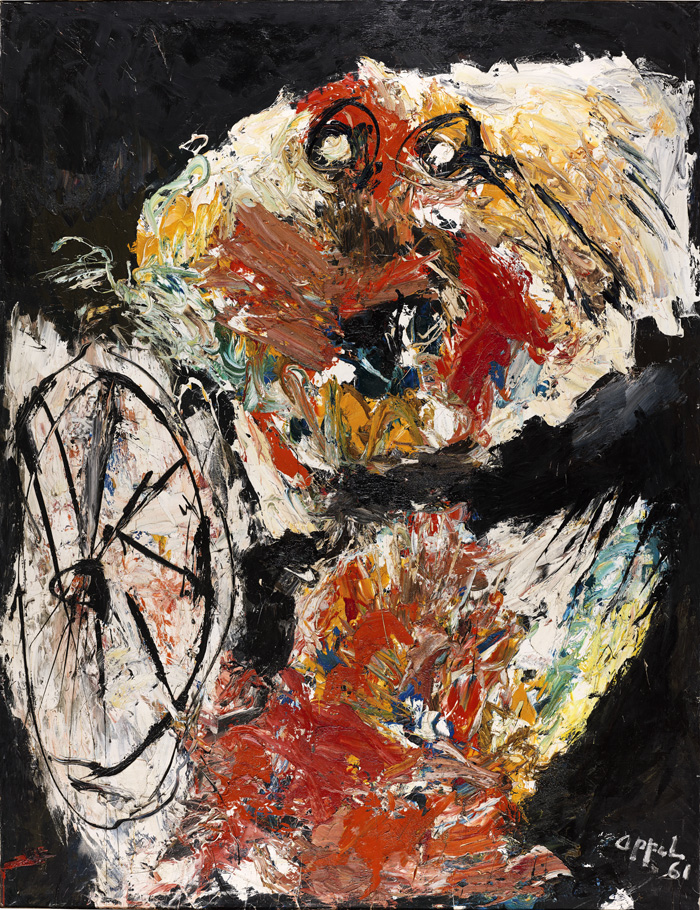Whitehot Magazine
May 2024
"The Best Art In The World"
"The Best Art In The World"
May 2024
Karel Appel and the Influence of Outsider Art
 Karel Appel, Little Hip Hip Hourra, 1949. Courtesy Musée d'Art moderne de la Ville de Paris © Karel Appel Foundation / ADAGP, Paris 2017
Karel Appel, Little Hip Hip Hourra, 1949. Courtesy Musée d'Art moderne de la Ville de Paris © Karel Appel Foundation / ADAGP, Paris 2017
By PAUL LASTER, Oct. 2017
Jean Dubuffet described Art Brut as art “created from solitude and from pure and authentic creative impulses.” Watching Karel Appel create a painting in Jan Vrijman’s 1962 film The Reality of Karel Appel unmasks the kinship the Dutch artist had to this self-taught realm. Attacking the canvas with splashes of paint and a cake spatula, he declares, “I paint like a barbarian in a barbarian age.”
The subject of a talk at the Outsider Art Fair in Paris this month, Appel is one of the most celebrated Dutch artists—along with Piet Mondrian and Willem de Kooning—of the 20th century. Making his first artworks while still a teenager, Appel entered the Rijksakademie in Amsterdam in 1942, but his education was cut short when he was forced to go into hiding from the Nazis.
 Ed van der Elsken, Still photo of Karel Appel from the film by Jan Vrijman, The Reality of Karel Appel, 1961 © Ed van der Elsken / Nederlands Fotomusuem. Courtesy Annet Gelink Gallery, Amsterdam
Ed van der Elsken, Still photo of Karel Appel from the film by Jan Vrijman, The Reality of Karel Appel, 1961 © Ed van der Elsken / Nederlands Fotomusuem. Courtesy Annet Gelink Gallery, Amsterdam
Living the vagabond life of a bohemian artist, Appel received his first big break when his promising work was included in the 1946 exhibition Young Painters at the Stedelijk Museum in Amsterdam. The following year he made his initial trip to Paris, where he saw the work of Dubuffet and his collection of Outsider Art—Le Foyer de l’Art Brut—at Galerie René Drouin.
Dubuffet and his collection had a profound effect on Appel. Upon returning to Amsterdam he started making a series of naive figurative works, which he titled Questioning Children, and he continued to create these types of inspired drawings and paintings well into the next decade. This turn in his work steered Appel in the direction of his next big move—cofounding the art movement CoBrA.
Named for the initials of the members' home cities: Co (Copenhagen), Br (Brussels) and A (Amsterdam), CoBrA was formed in 1948 by Appel, Constant, Corneille, Christian Dotremont, Asger Jorn and Joseph Noiret at the Café Notre-Dame in Paris. Complete with a manifesto, the leftist group rejected Western aesthetics and embraced spontaneity and collaborative working methods, while drawing inspiration from children’s drawings, primitive art and the art of the insane.
 Karel Appel, The Desert Dancers, 1954. Courtesy Musée d'Art moderne de la Ville de Paris © Karel Appel Foundation / ADAGP, Paris 2017
Karel Appel, The Desert Dancers, 1954. Courtesy Musée d'Art moderne de la Ville de Paris © Karel Appel Foundation / ADAGP, Paris 2017
Short-lived for an art movement—but long at having an impact on contemporary art— CoBrA was dissolved in 1951, but not before its members participated in the 1949 exhibition “International Experimental Art” at the Stedelijk Museum and Appel made one of his most significant works, Psychopathological Notebook, a picture-less pamphlet from an international exhibition of art by the mentally ill at Sainte-Anne Hospital in Paris that the artist modified with his own impulsive drawings and collages in 1950.
Adding a diverse group of characters—ranging from birds and beasts to abstract figures and scribbles—that were aggressively painted and drawn by Appel in gouache, felt-tip pen, pencil and crayon, the imagery obscured the pamphlet’s text and was also collaged over it. Although he had not yet attained his reputation as “the enfant terrible of post war European art,” Appel showed that he was one with the psychopathological artists he admired.
Living in Paris, Appel’s work was championed by the influential critic and curator Michel Tapié, who included it in important exhibitions and recommended it to the American art dealer Martha Jackson. In 1954, Appel represented the Netherlands at the 27th Venice Biennale and had his first solo show in the United States at Jackson’s New York gallery, where he continued to exhibit for the next 17 years.
 Karel Appel, Portrait of Count Basie, 1957. Courtesy Phoenix Art Museum © Karel Appel Foundation / ADAGP, Paris 2017
Karel Appel, Portrait of Count Basie, 1957. Courtesy Phoenix Art Museum © Karel Appel Foundation / ADAGP, Paris 2017
Visiting New York for the first time in 1957, Appel befriended the Abstract Expressionist painters Franz Kline and Willem de Kooning while summering on Long Island and painted portraits of jazz musicians Count Basie and Sarah Vaughn in Sam Francis’ studio. Seeing de Kooning’s Woman series in the flesh would prove influential to Appel’s nudes, which he painted a few years later.
On top of his game at age 40, Jan Vrijman filmed him creating his wildly expressive canvases in his Paris studio in 1961. Grabbing gobs of paint with the spatula and squeezing it onto the canvas directly from the tube, Appel brutally brings the work to life in the film, or as he aptly stated, “I don’t paint, I hit. The expression has to be struck into the painting.”
As the 1960s progressed, Appel had a retrospective at the Stedelijk Museum Amsterdam and exhibited in documenta III in Kassel. Following the portraits, his work moved in the direction of standard Western art with the series of nudes and landscapes, although they were painted in his hard-hitting, painterly style.
 Karel Appel, Burning Child with Hoop, 1961. Courtesy Musée d'Art moderne de la Ville de Paris © Karel Appel Foundation / ADAGP, Paris 2017
Karel Appel, Burning Child with Hoop, 1961. Courtesy Musée d'Art moderne de la Ville de Paris © Karel Appel Foundation / ADAGP, Paris 2017
The times, however, were changing and as the art world flowed more toward Pop Art, Nouveau Réalisme and Minimalism, Appel’s expressionistic art started to fade from fashion. Spending more time making sculptures in this period, Appel created surreal works from colorfully painted olive tree roots, totems of virgins from painted scraps of wood and junk art assemblages from found objects.
Working between studios in France and New York in the 1970s, Appel met Annina Nosei, an art world celebrity whose body had been signed as an artwork by Piero Manzoni. She would later become famous for giving Jean-Michel Basquiat his first solo exhibition in her SoHo gallery, where he painted in the basement.
Nosei introduced Appel’s art to the Paris dealer Daniel Templon, who exhibited his work in 1980 and 1983, and Nosei presented his paintings at her New York gallery in 1984. If one were prone to connect the dots, one could assume that if Nosei showed Templon the Dutch artist’s work, she probably showed it to Basquiat, as well. There’s definitely an affinity between the two men’s style of painting, particularly in Basquiat’s ferocious heads and his childlike figures from his early works.
 Karel Appel, The Owlman no. 1, 1960. Courtesy Musée d'Art moderne de la Ville de Paris © Karel Appel Foundation / ADAGP, Paris 2017
Karel Appel, The Owlman no. 1, 1960. Courtesy Musée d'Art moderne de la Ville de Paris © Karel Appel Foundation / ADAGP, Paris 2017
Whether they actually met remains a mystery, but Appel’s solo exhibition at Annina Nosei Gallery did put him in the context of a hip, new art scene and brought his work to the attention of younger artists. Neo-Expressionism was the style of the moment and Appel was a master at pushing around paint.
In 1992, the Los Angeles County Museum of Art presented the artist’s Psychopathological Notebook in the controversial exhibition “Parallel Visions: Modern Artists and Outsider Art.” It was the first time it had ever been publicly displayed, but five years later Verlag Gachnang & Springer made it more widely available by publishing a facsimile, which included an interview by the American art historian Donald Kuspit and an essay by Rudi Fuchs, who was then director of the Stedelijk Museum and a long-time champion of Appel’s work.
Appel was named an Officer of the French Légion d’Honneur in 2003. Three years he passed away and was buried at Cimetière du Pere-Lachaise. Since his death, there’s been a steady stream of exhibitions of his work and resurgence of interest in both his practice and his fellow CoBrA artists.
 Karel Appel, Machteld (Nude Series), 1962. Courtesy Musée d'Art moderne de la Ville de Paris © Karel Appel Foundation / ADAGP, Paris 2017
Karel Appel, Machteld (Nude Series), 1962. Courtesy Musée d'Art moderne de la Ville de Paris © Karel Appel Foundation / ADAGP, Paris 2017
His work has been the subject of one-person museum shows organized by the Albertina in Vienna in 2007, the CoBrA Museum in Amstelveen in 2008, the Museum Jorn in Silkeborg in 2013, the Centre Pompidou in Paris in 2015, the Gemeentemuseum in The Hague and the Phillips Collection in Washington, D.C. in 2016 and in the exhibition “Karel Appel: Art as Celebration!” at the Musée d’Art Moderne de la Ville de Paris earlier this year.
In 2014, the gallery Blum & Poe, which has spaces in Los Angeles, New York and Tokyo, began working with the Karel Appel Foundation to represent his work. It presented a one-person exhibition at the gallery’s New York space in September of that year and a solo booth at Frieze London in October. The next year, Alison Gingeras curated "The Avant-Garde Won’t Give Up: Cobra and Its Legacy" its galleries in New York and Los Angeles.
The New York exhibition included the founders of the group, members of the Danish artist collective Helhesten (The Hell Horse), which had preceded it, and some related artists. The Los Angeles exhibition presented pieces by the core group, as well as works by younger artists who share the CoBrA spirit, including Joe Bradley, Mark Flood, Gelitin, Mark Grotjahn, Rashid Johnson, Eddie Martinez, Bjarne Melgaard, Albert Oehlen, A.R. Penck, Richard Prince, Julian Schnabel, Dana Schutz, Andra Ursuta, Don Van Vliet and others.
 Karel Appel, The Black Madonna, 1966. Courtesy Jaski Gallery, Amsterdam © Karel Appel Foundation / ADAGP, Paris 2017
Karel Appel, The Black Madonna, 1966. Courtesy Jaski Gallery, Amsterdam © Karel Appel Foundation / ADAGP, Paris 2017
Melgaard, a Norwegian contemporary artist who also makes expressionistic paintings and sculptures, was actually so inspired by Appel’s work that he took the facsimile of Psychopathological Notebook and modified it with his own drawings, collages and scribbles. Melgaard’s version of the notebook was presented with his related artworks in a 2016 exhibition at the New York art space Karma, which also published a special edition of it.
In light of the renewed interest from galleries and museums and with the Outsider Art Fair currently taking place in Paris, there could not be a better time to take a another look at the influence of self-taught artists on Karel Appel’s oeuvre and on the continuing impact of both CoBrA and Art Brut on contemporary artists. WM
 Karel Appel, Psychopathological Notebook, 1950. Courtesy Karel Appel Foundation, Amsterdam. © Karel Appel Foundation / ADAGP, Paris 2017
Karel Appel, Psychopathological Notebook, 1950. Courtesy Karel Appel Foundation, Amsterdam. © Karel Appel Foundation / ADAGP, Paris 2017

Paul Laster
Paul Laster is a writer, editor, curator, artist and lecturer. He’s a contributing editor at ArtAsiaPacific and Whitehot Magazine of Contemporary Art and writer for Time Out New York, Harper’s Bazaar Arabia, Galerie Magazine, Sculpture, Art & Object, Cultured, Architectural Digest, Garage, Surface, Ocula, Observer, ArtPulse, Conceptual Fine Arts and Glasstire. He was the founding editor of Artkrush, started The Daily Beast’s art section, and was art editor of Russell Simmons’ OneWorld Magazine, as well as a curator at P.S.1 Contemporary Art Center, now MoMA PS1.
view all articles from this author








